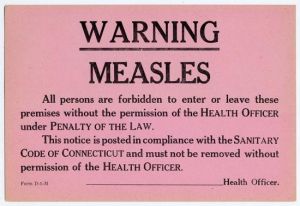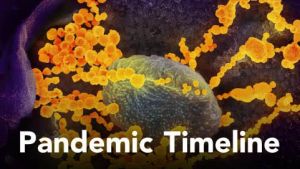
Subcontracting. Passaic home workshop pool. Even with the family quarantined for chicken pox, war production goes on in the basement workshop of George Carell, Passaic, New Jersey. (LOC)
On Sept. 20, The New York Times reported: Researchers at Cornell University who analyzed 38 million articles about the pandemic in English-language media around the world. Mentions of Mr. Trump made up nearly 38 percent of the overall “misinformation conversation,” making the president the largest driver of the “infodemic” — falsehoods involving the pandemic.”
For centuries, smallpox ravaged the world’s population. Caused by the variola virus, smallpox leads to fever, a serious rash and, in three out of every ten people, death. People that survived smallpox were often left with scars and other health issues.
Many methods of controlling smallpox were tried globally, with various levels of success. In the late 1700s, Dr. Edward Jenner observed that milkmaids exposed to cowpox seemed to have an immunity. He performed a successful experiment on a participant, forged ahead with his research and the modern era of smallpox vaccination was born.
A deadly outbreak of smallpox occurred in the United States from 1900 to 1925. One of the states hardest hit during this time period was Massachusetts, especially the areas surrounding Boston. There were 1,596 cases of smallpox in Boston from 1901-1903, with 270 deaths and a fatality rate of 17 percent.
By 1901, the Boston Board of Health put several measures in place to control smallpox, including creating quarantine facilities, a contact/exposure program and a voluntary vaccination program. The program was met with some skepticism over a lack of regulation and potential complications from the vaccine itself. Late in 1901, the Boston Board of Health ordered all individuals in Boston not vaccinated against smallpox since Jan. 1, 1897 to be vaccinated. Those who refused to get vaccinated were subject to a $5 fine or 15-day jail sentence. 
Henning Jacobson, a minister in Cambridge, Massachusetts, refused the order and was fined $5. In 1905, the Massachusetts Supreme Court denied his plea.
The judgement of the Massachusetts Supreme Court in 1905, was not whether the government should have taken control of controlling the smallpox epidemic in Massachusetts, but whether the state had the ability to fine individuals or sentence them to jail. Jacobson argued this was an overreach on the part of the state and an unconstitutional infringement on the rights of an individual.
The questions in the Jacobson case are the very issues we grapple with today in the COVID-19 era:
- The role of the state government vs. the federal government in securing the public health of individuals
- What powers localities have and what powers the federal government has to ensure the welfare of individuals
- Where do an individual’s civil liberties end and the rights of the public to be safe from disease begin
- Does the government have the right to infringe on the rights of individuals to safeguard the public
The Supreme Court, in Jacobson v. Massachusetts (1905), affirmed that states have the legislative authority, right, and, in fact, responsibility to protect the individuals in their state. They empowered states to pass laws for the “health, peace, morals, education and good order of the people.”
Jacobson v. Massachusetts remains law to this day. The protections utilized in Jacobson are referred to as “police power,” specifically the right of a state or locality to protect people from threats to their health and safety.
Police power has its roots in the 10th Amendment, which holds that powers not delegated to the federal government are reserved for the states and the people. It specifically refers to the ability of states to regulate the health, safety and general welfare of individuals within the state. It is this power that allows the plethora of executive orders, ordinances, policies and laws that we have seen enacted at the state and local level during COVID-19, from enforcement of wearing masks to closing of indoor dining in restaurants to contact tracing provisions to requirements around social distancing.
While the federal government has an investment in the health and safety of the public, the police power and 10th Amendment entrust this responsibility to the states. The Jacobson ruling may be a way to predict challenges over contact tracing, further ordinances around social distancing, and of course a possible effective vaccination.
So wear the mask.




